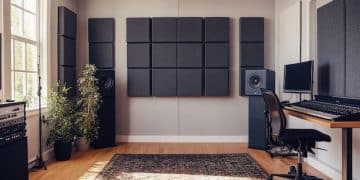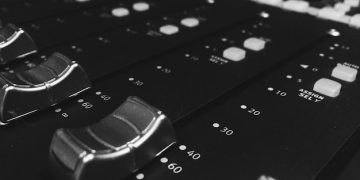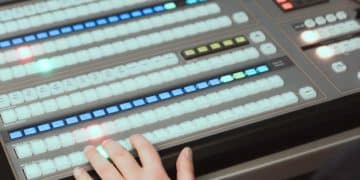Understanding Audio Interfaces: Choosing the Right Interface for Your Needs
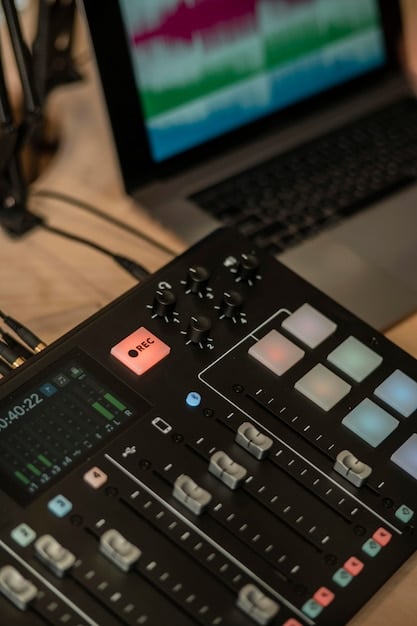
Understanding audio interfaces involves recognizing their crucial role in music production for converting analog signals into digital data, thus selecting the right interface ensures optimal recording quality and compatibility with your equipment and software.
Navigating the world of audio interfaces can feel overwhelming. Understanding audio interfaces: choosing the right interface for your needs is crucial for any musician, producer, or sound engineer looking to capture high-quality audio. Let’s demystify the process and make sure you pick the perfect interface for your setup.
What is an Audio Interface and Why Do You Need One?
An audio interface is the bridge between your instruments and your computer. It converts analog signals from microphones and instruments into digital signals that your computer can understand, and vice versa. But why can’t you just plug directly into your computer?
The sound card in your computer isn’t designed for high-quality audio recording. Audio interfaces offer superior sound quality, lower latency, and more versatile input/output options. They provide the crucial link for achieving professional-sounding recordings.
Improved Audio Quality
One of the primary benefits of using an audio interface is the improvement in audio quality. Interfaces utilize high-quality preamps and converters that significantly enhance the clarity and detail of your recordings.
Lower Latency
Latency, the delay between playing an instrument and hearing it through your speakers, can be a major headache. An audio interface drastically reduces latency, allowing for real-time monitoring and performance.
Versatile Input/Output Options
Audio interfaces come with a variety of input/output options, accommodating different types of instruments and devices. This flexibility ensures you can connect all your gear seamlessly.
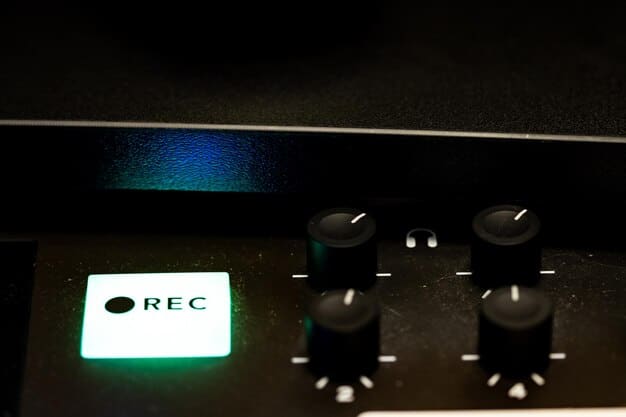
- Preamps: High-quality preamps amplify the signal from your microphones, ensuring a clean and strong recording.
- Converters: Analog-to-digital (A/D) and digital-to-analog (D/A) converters accurately translate audio signals between the analog and digital domains.
- Connectivity: Multiple input and output options allow for connecting various instruments, microphones, and monitors.
In summary, an audio interface is essential for achieving professional-quality audio recordings. It offers superior sound quality, lower latency, and versatile input/output options, making it a cornerstone of any recording setup.
Understanding Key Features of Audio Interfaces
When choosing an audio interface, several key features should be considered. These features determine the interface’s capabilities and how well it suits your specific needs. Let’s explore some of the most important aspects.
Understanding these features will help you make an informed decision and select an interface that meets your recording requirements for years to come.
Input/Output (I/O) Count
The number of inputs and outputs your interface has is crucial. Consider how many microphones and instruments you plan to record simultaneously.
Preamps
High-quality preamps are essential for capturing clean and detailed recordings. Look for interfaces with reputable preamp designs or the option to use external preamps.
Connectivity Options (USB, Thunderbolt, etc.)
The type of connection your interface uses can impact its performance. USB is common and versatile, while Thunderbolt offers faster speeds and lower latency.
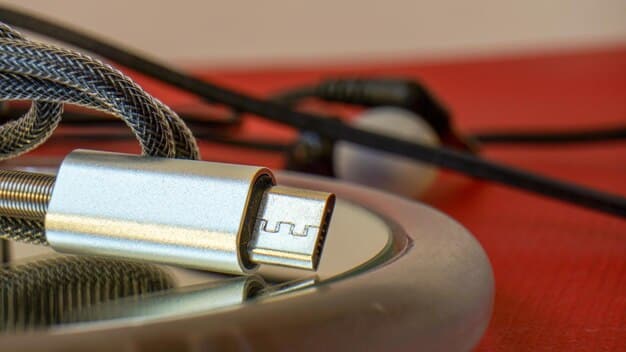
- Input Needs: Assess the number of inputs you need for microphones, instruments, and other audio sources.
- Output Needs: Determine the number of outputs required for monitors, headphones, and external effects processors.
- Future Expansion: Consider whether you might need additional inputs and outputs in the future.
These key features play a crucial role in the performance and versatility of an audio interface. By understanding these aspects, you can make a more informed decision and select an interface that perfectly fits your needs.
Types of Audio Interfaces: USB, Thunderbolt, and More
Audio interfaces come in various types, each with its own advantages and disadvantages. The connection type (USB, Thunderbolt, etc.) significantly impacts the interface’s performance and compatibility. Let’s delve into the different types available.
Choosing the right type of audio interface is essential for ensuring optimal performance and compatibility with your computer and other equipment. Understanding the differences between these types will help you make the best decision.
USB Audio Interfaces
USB interfaces are the most common type, offering a balance of affordability, compatibility, and performance. They are easy to set up and work with most computers.
Thunderbolt Audio Interfaces
Thunderbolt interfaces offer the fastest speeds and lowest latency, making them ideal for demanding recording sessions. They are typically more expensive but deliver superior performance.
Other Connection Types: FireWire, PCIe
While less common, FireWire and PCIe interfaces still have their place. FireWire offers decent performance, while PCIe interfaces can provide very low latency but require installation inside your computer.
Consider the pros and cons of each type, balancing your budget with your performance needs to find the best fit.
Matching Your Interface to Your Recording Needs
The right audio interface depends heavily on your specific recording needs. Whether you’re a solo musician, a band recording live, or a podcaster, your interface should match your requirements. Let’s explore how to match your interface to your recording needs.
By carefully considering your specific needs and matching them with the right audio interface features, you can create an optimal recording setup that delivers professional results.
For Solo Musicians
If you’re a solo musician, a simple interface with one or two inputs might suffice. Focus on sound quality and low latency for recording vocals and instruments.
For Bands and Live Recording
Bands and live recording require interfaces with multiple inputs and outputs to capture all instruments and vocals simultaneously. Look for interfaces with expandable options.
For Podcasting and Voiceovers
Podcasting and voiceovers typically require a single high-quality microphone input. Focus on interfaces with excellent preamps and clear sound reproduction.
- Solo Singer-Songwriter: A 2-in/2-out interface with a quality preamp is often sufficient.
- Small Band: An 8-in/8-out interface allows for recording multiple instruments simultaneously.
- Electronic Music Producer: An interface with MIDI connectivity and low latency is ideal for virtual instruments.
Matching your interface to your recording needs ensures you have the right tools to capture high-quality audio, whether you’re a solo artist, a band, or a podcaster.
Setting Up and Troubleshooting Your Audio Interface
Setting up your audio interface correctly is crucial for optimal performance. Knowing how to troubleshoot common issues can save you time and frustration. Let’s walk through the setup process and common troubleshooting tips.
A smooth setup and effective troubleshooting skills are essential for making the most of your audio interface and ensuring uninterrupted recording sessions.
Installation and Driver Setup
Follow the manufacturer’s instructions for installing the interface and its drivers. Ensure your operating system is compatible and up to date.
Configuring Your DAW
Select your audio interface as the input and output device in your digital audio workstation (DAW). Adjust buffer settings to optimize latency and performance.
Common Troubleshooting Tips
If you encounter issues, check your connections, update drivers, and consult the interface’s manual. Online forums and support resources can also be helpful.
- Check Connections: Ensure all cables are securely connected and functioning properly.
- Update Drivers: Keep your audio interface drivers up to date for optimal performance.
- Adjust Buffer Size: Experiment with buffer size settings to minimize latency without causing audio glitches.
By following these setup steps and troubleshooting tips, you can ensure your audio interface performs optimally, allowing you to focus on creating great music.
| Key Point | Brief Description |
|---|---|
| 🎤 Importance of Audio Interfaces | Essential for improving audio quality and reducing latency in recordings. |
| ⚙️ Key Interface Features | Includes I/O count, preamp quality, and connectivity options like USB and Thunderbolt. |
| 💻 Interface Types | USB for versatility, Thunderbolt for speed, and others like FireWire and PCIe. |
| 🛠️ Setting Up & Troubleshooting | Proper installation, correct DAW configuration, and checking connections are crucial. |
Frequently Asked Questions
▼
Latency is the delay between inputting a signal and hearing it. Low latency is crucial for real-time monitoring and performance, ensuring a seamless recording experience without distracting delays.
▼
The number of inputs depends on what you plan to record simultaneously. Solo artists might need just two, while bands recording live should look for at least eight inputs on their interface.
▼
USB interfaces offer broad compatibility and affordability, while Thunderbolt interfaces provide faster speeds and lower latency. Thunderbolt is often preferred for professional recording due to its superior performance.
▼
Many audio interfaces come with built-in preamps, but using an external preamp can enhance the sound quality. If you are seeking high-end professional audio, consider investing in an external preamp.
▼
Visit the manufacturer’s website and download the latest drivers for your operating system. Proper driver updates ensure that your audio interface functions smoothly and efficiently with your computer.
Conclusion
Choosing the right audio interface is a critical step in setting up your recording environment. By understanding audio interfaces: choosing the right interface for your needs, recognizing the key features, and matching your interface to your specific recording needs, you can ensure professional-quality audio capture for all your musical endeavors.
